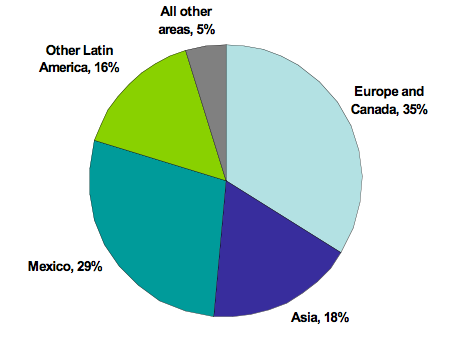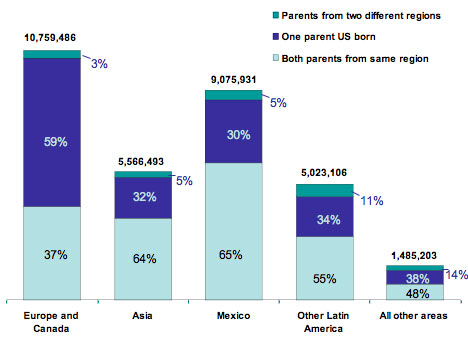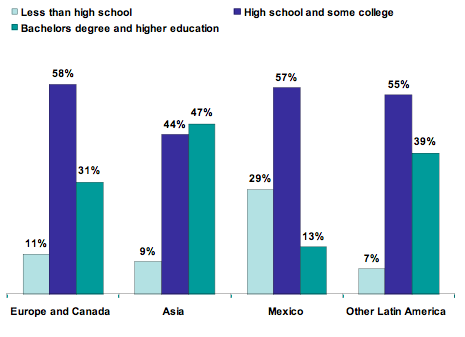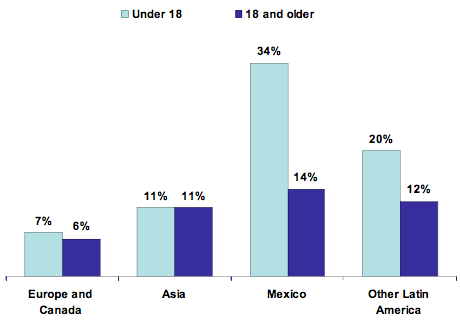The Second Generation in the United States
The degree to which immigrant groups integrate is determined by many factors, including their educational backgrounds, work experiences and skills, and culture, as well as the communities in which they settle.
Therefore, it is important to examine variations in the characteristics of the second generation, defined as native born who have at least one foreign-born (first-generation) parent. The third-and-later generation includes native-born individuals with both parents born in the United States.
Members of the second generation whose parents came from Europe are more likely to be children of immigrants who arrived before 1960. They exhibit different characteristics than the children of more recent immigrants from Asia and Latin America.
This Spotlight examines the general social and demographic characteristics of the second generation in the United States by world region of origin. Those with origins in Canada have been grouped with those of European descent because they exhibit similar characteristics.
Distinctions are made between those with origins in Mexico and those with origins elsewhere in Latin America as Mexicans are the largest immigrant group in the United States and are of particular interest to policymakers. Members of the second generation with parents born in more than one world region are included in the figures for each region and are therefore counted twice.
Note: The results here are based on 2005 and 2006 Current Population Survey (CPS) data, which were averaged in order to provide a large enough sample size.
Click on the bullet points below for more information:
- The second generation accounted for nearly 11 percent of the U.S. population in 2006.
Special Note Data points in this article cite the most recent survey year (2006) although the numbers are based on an average of CPS data from 2005 and 2006.
The data reflect only the population living in households and exclude those living in group quarters, such as institutions and college dormitories. - Two of every three members of the second generation have parents born in Mexico, Europe, or Canada.
- More than two of every five members of the second generation have a U.S.-born parent.
- Members of the second generation with Mexican and Asian roots were more likely to have two parents born in the same world region.
- The second generation tend to be very young.
- The second generation of European and Canadian origin are four times older than those with origins in other areas.
- Members of the second generation are more likely to finish college than both the foreign born and members of the third-and-higher generation.
- The second generation with origins in Asia and Latin America (other than Mexico) show high levels of educational attainment.
- One in every five second-generation children and one in 10 second-generation adults are in poverty.
- More than a third of second-generation children with Mexican roots live in poverty.
The second generation accounted for nearly 11 percent of the U.S. population in 2006.
About 12 percent (35,436,774 individuals) of the U.S. population are foreign born, 11 percent (30,994,680) are second generation, and 77 percent (226,068,824) are third-or-later generation.
Two of every three members of the second generation have parents born in Mexico, Europe, or Canada.
About 35 percent (10,759,486) of the second generation have parents born in Europe or Canada, while 29 percent (9,075,931) have parents born in Mexico (see Figure 1). Asia was the next largest birthplace of parents of the second generation with 18 percent (5,566,493), followed by Latin America (other than Mexico) at 16 percent (5,023,106), and all other regions at five percent (1,485,203).
|
More than two of every five members of the second generation have a U.S.-born parent.
Among the second generation, 42 percent (13,128,071) have one foreign-born parent and one parent born in the United States. Nearly 55 percent (16,951,070) have two foreign-born parents with birthplaces in the same world region, and three percent (915,539) have parents born in two different world regions (e.g., Europe and Latin America).
Members of the second generation with Mexican and Asian roots were more likely to have two parents born in the same world region.
As Figure 2 shows, the children of parents from Mexico and Asia are more likely to have both parents from the same region of birth, while those whose parents are from Europe and Canada are more likely to have one foreign-born and one U.S.-born parent. Those with parents from Latin America (other than Mexico) and other world regions not individually classified were most likely to have two foreign-born parents from different world regions.
|
The second generation tend to be very young.
The median age of the second generation is 21 years, compared with 38 years among the foreign born, and 37 years among the third-and-later generation. The young age of the second generation reflects the large, recent wave of immigrants to the United States.
The second generation of European and Canadian origin are four times older than those with roots in other areas.
At 54 years, the median age of the European/Canadian-origin second generation is much older than second-generation members with origins in other areas. The median age for those whose parents are from Asia is 16 years, from Mexico 12 years, from elsewhere in Latin America 13 years, and from all other areas 14 years.
Members of the second generation are more likely to finish college than both the foreign born and members of the third-and-higher generation.
About 31 percent (4,299,844) of the second generation 25 and older have completed a four-year college degree or higher compared with 27 percent (7,882,782) of the foreign born and 28 percent (40,867,953) of the third-and-later generation.
At the lower end of the educational spectrum, 13 percent (1,862,569) of the second generation have less than a high school education compared with 32 percent (9,287,483) of the foreign born and 11 percent (16,805,676) of the third-and-later generation.
The second generation with origins in Asia and Latin America (other than Mexico) show high levels of educational attainment.
Among the second generation 25 and older, 47 percent (846,424) of those with Asian origins and 39 percent (425,055) of those with Latin American origins (excluding Mexico) have a bachelor's degree or higher (see Figure 3). Of those with one or more parents born in Mexico, 29 percent (690,543) have completed high school.
|
One in every five second-generation children and one in 10 second-generation adults are in poverty.
About 22 percent (3,068,753) of second-generation children under age 18 are in poverty compared with 31 percent (965,726) of foreign-born children and 17 percent (9,559,125) of third-and-later-generation children (see Figure 4).
About nine percent (1,548,025) of second-generation adults 18 and older are in poverty, while 16 percent (5,016,996) of foreign-born adults and 10 percent (17,460,798) of third-and-later-generation adults live below the poverty line.
A person's poverty status is determined by comparing the person's total family income with the poverty threshold appropriate for that person's family size and composition. According to the U.S. Census Bureau, the poverty threshold in 2005 for a family of four was $19,806.
|
More than a third of second-generation children with Mexican roots live in poverty.
As Figure 4 shows, 34 percent (1,934,061) of young second-generation children whose parents were born in Mexico live below the poverty line. The next-highest rate of poverty is among young children of those from elsewhere in Latin America (20 percent or 641,646 individuals). Second-generation adults with Mexican origins are also most likely to live in poverty at 14 percent (474,883), although the disparities flatten among the groups.






